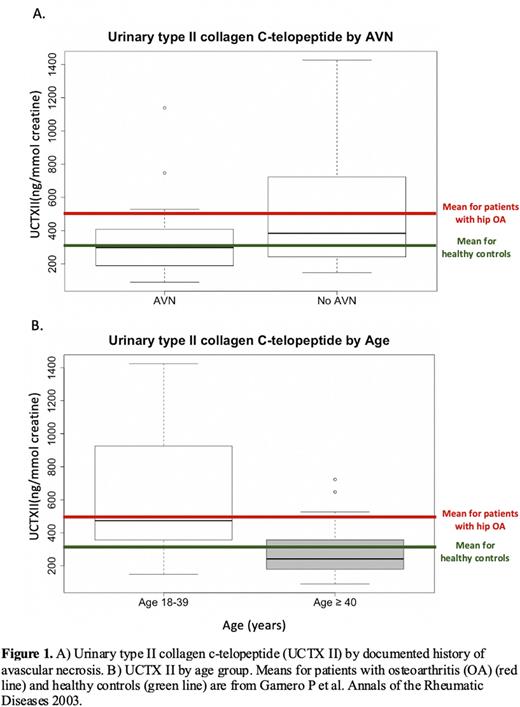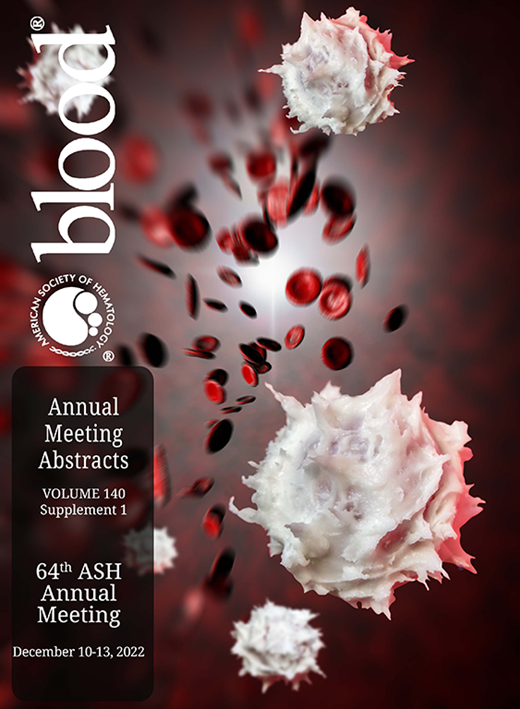Abstract
Background
Avascular necrosis (AVN) is a common cause of morbidity and impaired mobility in adults with sickle cell disease (SCD). Repeated episodes of vaso-occlusion cause bone infarctions that lead to AVN. The early detection of AVN in adults with SCD requires expensive imaging modalities (CT, MRI) as it is often not detected on plain radiographs until advanced stages. Type II collagen is an abundant protein of the cartilage matrix and its degradation product, urinary type II collagen C-telopeptide (UCTX II) is a specific biomarker used to measure degradation of articular cartilage in adults with osteoarthritis (OA). UCTX II is easily measured in urine samples and may facilitate early detection of AVN and other bone diseases seen in SCD.
The primary objective of this study is to assess the relationship between concentrations of UCTX II and avascular necrosis in adults with SCD.
Methods
We included adults (≥ 18 years) with a laboratory confirmed diagnosis of SCD in this cross-sectional study. We collected sociodemographic data by patient survey and extracted medical history and routine laboratory data from the electronic health record including history of AVN and joint surgery which were confirmed by participant survey. History of arthritis included in the participant survey. We collected urine and blood specimens and administered physical performance measures on the same day during the participant's usual state of health. We defined usual health as no hospitalizations in the last 6 weeks and no emergency room or Sickle Cell Day Hospital visits in the 2 weeks prior to the assessment and specimen collection. We quantified UCTX II by ELISA and corrected for creatinine excretion. We used descriptive statistics and visual displays to summarize the data and compared UCTX II levels between participants with and without AVN using Wilcoxon rank sum test. We evaluated relationships between UCTX II and physical performance measures using Spearman's correlation coefficients.
Results
We measured UCTX II in 34 participants. The median age of participants was 48.5 years (range 20-71). Most (62%) participants were ≥ 40 and 38% were between 18-39 years old. SCD genotypes included HbSS (56%), HbSβ0 (3%) and HbSβ+-thalassemia (12%), and HbSC (29%). Most participants (59%) had a diagnosis of AVN, 24% had a history of joint surgery, and 29% had reported a history of arthritis.
The median UCTX II level was 348 ng/mmol creatinine (IQR 229-534; range 89 - 78230). Younger adults had significantly higher median UCTX II levels compared to older adults with a median UCTX II of 536 (IQR 358 - 999) in young adults versus 242 (IQR 180 - 357) in older adults; p-value = 0.001.
There was not a statistically significant difference in median UCTX II level between participants with and without AVN, history of joint surgery, and self-reported history of arthritis. When we controlled for age using a rank-based nonparametric ANCOVA, there remained no difference in UCTX II levels between participants with and without AVN (p-value = 0.68).
Participants with a history of AVN had a median UCTX II level of 311 (IQR 209 - 426) compared to a median of 384 (IQR 248 - 704) in participants without AVN; p-value = 0.22.
Participants with a history of joint surgery had a median UCTX II level of 283 (IQR 139 - 371) compared to participants with no history of joint surgery with a median of 357 (IQR 233 - 620); p-value = 0.27. Participants with a history of self-reported arthritis had a median UCTX II level of 312 (IQR 245 - 353) compared to patients without arthritis who had a median of UCTX II of 382 (IQR 217 - 673); p-value = 0.27.
Conclusion
This preliminary data showed no significant difference in UCTX II levels between adults with and without AVN, history of joint surgery, or self-reported history of arthritis; however, the small sample size limited statistical power to detect differences. We found that younger adults with SCD had higher UCTX II levels than older adults with SCD. The increased UTCXII in younger adults with SCD is consistent with prior studies that demonstrate higher UCTXII in young adults and a gradual decline with age due growth plate activity that contributes to the higher UCTXII levels seen in young adults. The role of UCTXII will need to be explored further in a larger sample and compared to radiographic staging of AVN that includes evaluation of joint damage.
Disclosures
Strouse:Takeda: Consultancy.
Author notes
Asterisk with author names denotes non-ASH members.


